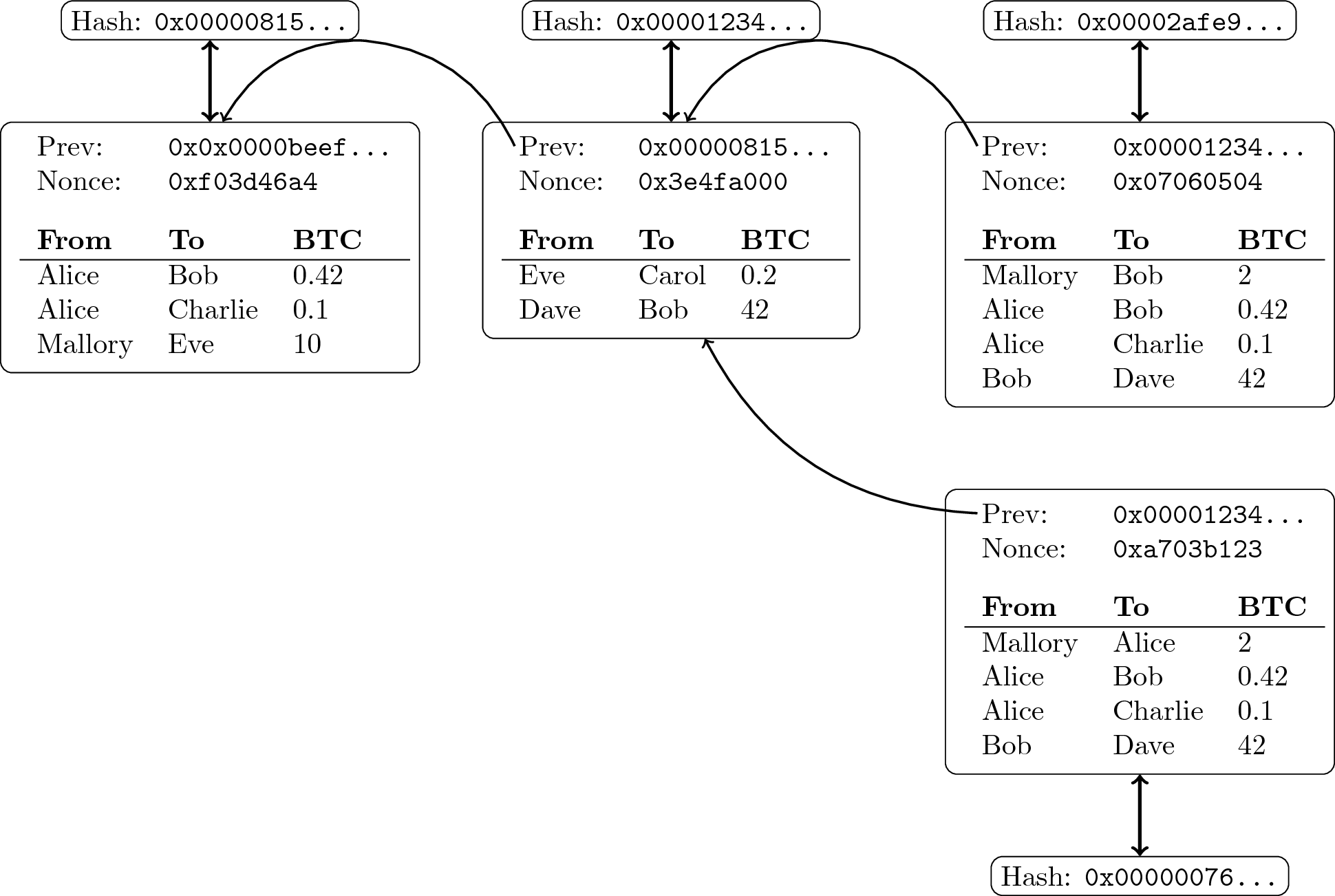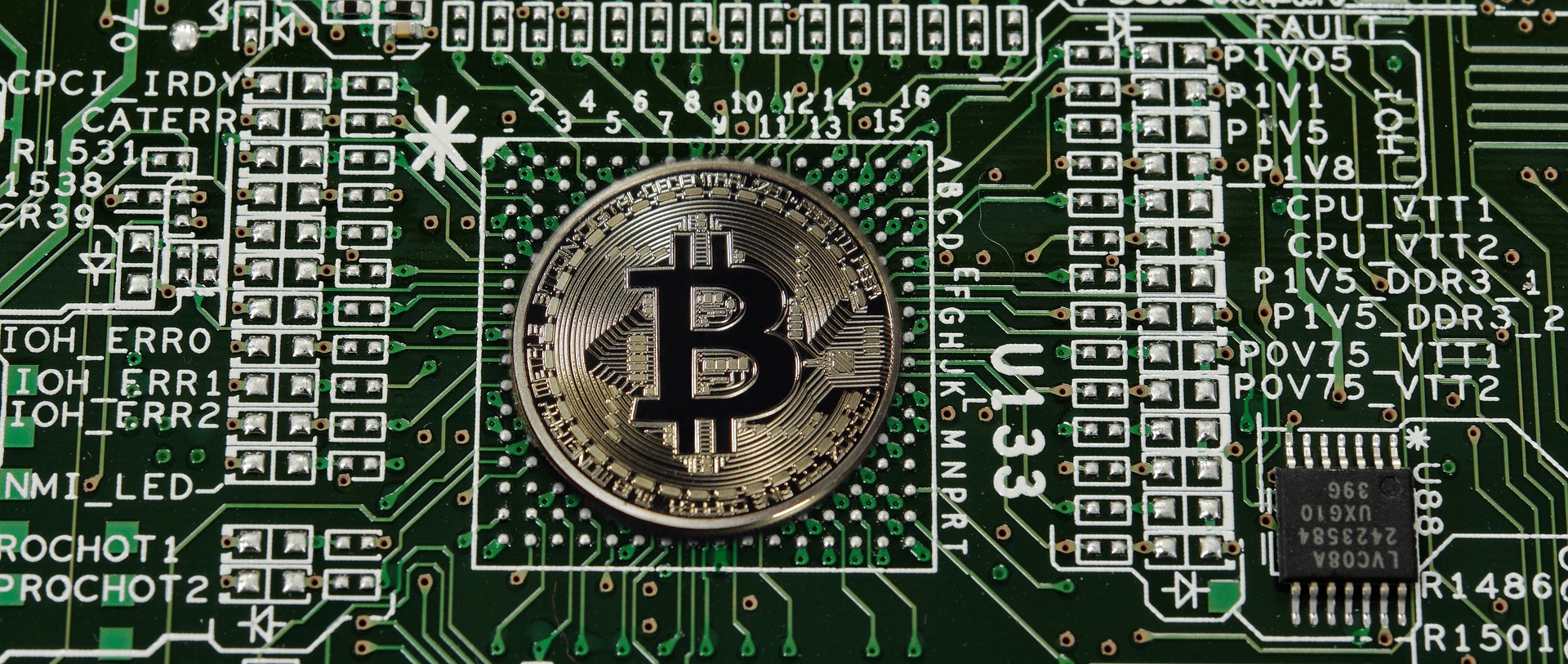Blockchain Introduction
(Usage hints for this presentation)
VM Neuland im Internet 2021
Dr. Jens Lechtenbörger (License Information)
Agenda
1 Introduction
1.1 Last Week Tonight with John Oliver
March 2018, on crypto currencies: “Everything you don’t understand about money combined with everything you don’t understand about computers”
- (My addition: And everything you don’t understand about game theory)
1.2 Bitcoin’s Academic Pedigree
- Survey
[NC17] by Narayanan and Clark
- Nearly all technical components of bitcoin originated in academic literature (1980s, 1990s)
- Nakamoto stood on shoulders of giants
- Focus on “Nakamoto’s true leap of insight—the specific, complex way in which the underlying components are put together”
- Details far beyond this presentation!
1.3 Omissions
- Focus here on blockchains à la Bitcoin, i.e., public/permissionless with proof of work consensus
- Beyond that, see survey [DLZ+17]
- Ethereum, Parity, Hyperledger Fabric, private blockchains, proof of stake, PBFT, non-byzantine consensus variants, smart contracts, and more.
- “The results show that current blockchains’ performance is limited, far below what a state-of-the-art database system can offer.”
2 Terminology
2.1 Crypto Recap
- “Blockchain” uses standard cryptographic primitives
- Collision-resistant cryptographic hash function
- Map any data to “unique” hash value of fixed length, e.g., 256
bits in hexadecimal
0x420815abc...- Digital fingerprint, cryptographic digest
- Finding collisions must be computationally infeasible
- Map any data to “unique” hash value of fixed length, e.g., 256
bits in hexadecimal
- Digital signatures (asymmetric cryptography)
- Participants own key pairs: private and public key
- Alice creates signature on document with her private key
- Bob uses her public key to verify signature
- Proof that document (a) came from Alice (authentication, non-repudiation) and (b) unchanged by anybody else (integrity)
- Alice creates signature on document with her private key
- Participants own key pairs: private and public key
2.1.1 Key Pairs in Bitcoin
“Account” (part of wallet) tightly coupled with key pair
- Public key used like account number
- Transfer of bitcoins “to” public key
- Private key used to authenticate “transactions”
- Alice signs transfer of bitcoins from her account to Bob’s with her associated private key
- Everybody can verify that transfer with Alice’s public key
- (Whoever has access to the private key can transfer coins)
- (Remember Mt. Gox? 650,000 bitcoins “lost”)
- Public key used like account number
2.1.2 Hash Pointers
- If collision resistance is given, we can identify any data with
its hash value
- (If data changes, the hash value changes)
- E.g., data represents a block of transactions
- That block is stored at some address
- With hash pointers, we not only record the address but also the block’s hash value
When retrieving the block, verify that it is unchanged
![Block of transactions with hash pointer]()
“Block of transactions with hash pointer” by Jens Lechtenbörger under CC BY-SA 4.0; from GitLab
2.1.3 Chaining Data
- Append-only logs can be constructed by chaining blocks with hash
pointers
- Typically, blocks organized as Merkle trees
- Leaf nodes are transactions, internal nodes are hash pointers
- Hash of tree’s root serves as digest for block
- Inclusion proofs (of transactions) possible with little data
- Typically, blocks organized as Merkle trees

“Block chain of transactions” by Jens Lechtenbörger under CC BY-SA 4.0; from GitLab
2.2 Bitcoin Basics
2.2.1 Bitcoin Origin
Announcement of bitcoin as “P2P e-cash” on Cryptography Mailing List on 2008-10-31 by Satoshi Nakamoto
- Link to famous paper [Nak08]
- [Nak08] does neither mention “blockchain” nor “block chain” (but “chain” and “block”)
- Source code for bitcoin announced later on 2009-01-08
2.2.2 Bitcoin Goals
- Decentralized currency
- No central authority; neither to issue coins nor to create accounts nor to monitor transactions
- Peer-to-peer network of miners solves cryptographic puzzle to extend blockchain as “ledger of transactions”
- Proof of work
- Blockchain = data structure ≠ database
- (Database system = DBMS + managed DBs)
- Replicated among miners
2.2.3 Bitcoin Security
- Ownership of coins with digital signatures, no double-spending
- Do not promise “same coin” to multiple parties
- Miners check whether amount of proposed transaction unspent in current blockchain
- Consensus
- Blockchain is probabilistically append-only (revisited below)
- No way to revoke/undo transactions
- Do not promise “same coin” to multiple parties
2.2.4 Bitcoin Transactions
- Transfer of coins from one account to another
- Blocks in blockchain contain multiple transactions
- When new block is mined, first transaction allows miner to transfer block reward to own account
- This creates new coins
- Amount of new coins per blocked halved about every 4 years (started at 50; 6.25 since May 2020)
- Transactions can have multiple inputs and output (graphics here are simplified to show just one input and one output)
- Inputs refer to (hashes of) transactions
- Outputs subsume fees (to miner) and change (to sender)
3 The Blockchain?
3.1 The Block Chain
- Comments in the source code of bitcoin mention “block chain”.
E.g.,
main.h#l1013// // The block chain is a tree shaped structure starting with the // genesis block at the root, with each block potentially having multiple // candidates to be the next block. pprev and pnext link a path through the // main/longest chain. A blockindex may have multiple pprev pointing back // to it, but pnext will only point forward to the longest branch, or will // be null if the block is not part of the longest chain. // class CBlockIndex
- Also for
CBlock,CWalletTx,CMerkleTx
3.1.1 Trees of Blocks
- The “chain” is expected to fork into branches
- A tree structure emerges
- The longest (actually, the most work-intensive) chain of that tree records “the truth” in Bitcoin

“Block tree of transactions” by Jens Lechtenbörger under CC BY-SA 4.0; from GitLab
3.2 The “Blockchain” in Bitcoin
- Tree-based data structure as just explained
- No database! (Thus, no distributed database either!)
- Replicated/copied among P2P network of miners
- Extended asynchronously
- After solving a cryptographic puzzle: Proof of work
- Different miners may work on different versions (forks, branches, orphans)
- Extended asynchronously
- Does each miner maintain “a blockchain”?
- Comment above suggests so
- Is the entire set of chains of blocks “the blockchain” (of bitcoin)?
4 Blockchain Characteristics
4.1 Distributed Ledger?
- What exactly is a “ledger”?
- Why invent a new term for a persistent, tamper-proof data structure?
- “Distributed” does not carry much defining value in blockchain contexts.
- E.g., Google’s infrastructure using Paxos [Lam98] is distributed, yet controlled centrally.
4.2 Decentralized, Public, Open, Replicated?
- No central control, no intermediaries/middlemen
- Anyone can take part
- Obtain copy
- Take part in maintenance/consensus
4.2.1 Reflection
- Who does take part in Bitcoin’s blockchain?
- Initially, anybody’s PC was good enough
- [SZ18] Then GPUs,
now millions of dollars for ASICs
- Barrier-to-entry
- But also barrier-to-exit
- Special-purpose hardware not much use for anything else
- [GBE+18] Analysis of 10 months of data, starting July 2016
- Weekly mining power of top Bitcoin miner about 20%
- (Ethereum: 25%)
- Top 4 Bitcoin miners have more than 53% of mining power
- (Top 3 with 61% in Ethereum)
- 90% of mining power controlled by 16 Bitcoin miners
- (11 in Ethereum)
- Weekly mining power of top Bitcoin miner about 20%
4.3 Immutable, Append-Only?
- Frequently, blockchains are called immutable
- Clearly, they are append-only at best
- Bitcoin only offers probabilistic guarantees
- Forks/orphans violate append-only property

“Block tree of transactions” by Jens Lechtenbörger under CC BY-SA 4.0; from GitLab
4.4 Designed to Persist?
- Bitcoin defines rules for mining
- E.g., mine on longest chain, publish mined blocks, include all known transactions
- Block rewards, transaction fees as incentives
- Rational miners may behave differently
- [ES14]: Selfish mining
- Technique to collect block rewards beyond expected share corresponding to mining power
- [CKW+16]: Rules change when block rewards are negligible and
transaction fees dominate
- Selfish mining even more profitable
- New undercutting attacks
- “At worst, consensus will break down due to block withholding or increasingly aggressive undercutting.”
- [ES14]: Selfish mining
4.5 Justifiable?
- Proof-of-work (Bitcoin, Ethereum) is ecologically disastrous. I find its use unethical.
Digiconomist estimates yearly Bitcoin energy consumption of 112 TWh as of 2021-05-09 (up from 61 TWh as of 2018-04-20).
- 1135 KWh per transaction
- Do you know your household’s monthly energy usage?
- 1135 KWh per transaction
- With rising bitcoin prices, miners invest more in energy …
- 2021-05-12: Tesla stopped accepting Bitcoins for fossil fuel usage
5 Conclusions
5.1 Summary
- Blockchains aim for decentralized consensus over shared data
- No database per se, but building block
- The blockchain does not exist
- Advertised characteristics need to be analyzed carefully
- As usual, choice of terms is crucial
- Ask for meaning/definition
5.2 Constructive Thoughts
- Different (blockchain) scenarios come with different requirements
- Specify requirements first
- Select supporting technology afterwards
- E.g., a digital notary service based on linked timestamping (see [NC17]) or a distributed database with replication may be good enough
5.2.1 Effect of Signatures
- Digital signatures (even without blockchain) provide tamper-proof,
verifiable, decentralized evidence of statements/transactions.
- (If implemented properly based on strong crypto.)
- Transactions in Bitcoin cannot be revoked.
- Attempts of double-spending have no negative effect on attacker.
- Double-spending “resolved” at cost of randomly chosen victim.
- Although attacker’s account is publicly visible!
- Is that a requirement for your blockchain scenario as well?
- Attempts of double-spending have no negative effect on attacker.
5.2.2 Sample Application Scenarios
- Educational certificates on blockchains
- Different security needs than e-cash
- Must be revocable, e.g., to punish plagiarism
- Double-spending not an issue
- Little incentive for educational institutions to lie about previously issued certificates
- Different security needs than e-cash
- Other certifications, e.g., for real-estate may be embedded into
legal regulations
- Double spending leads attacker into jail
- Certificate Transparency
- Notary service without blockchain
- Append-only, open to public audits
Bibliography
- [CKW+16] Carlsten, Kalodner, Weinberg & Narayanan, On the Instability of Bitcoin Without the Block Reward, in: Proceedings of the 2016 ACM SIGSAC Conference on Computer and Communications Security, 2016. https://doi.acm.org/10.1145/2976749.2978408
- [DLZ+17] Dinh, Liu, Zhang, Chen, Ooi & Wang, Untangling Blockchain: A Data Processing View of Blockchain Systems, IEEE Transactions on Knowledge and Data Engineering (accepted for publication) , (2017). https://doi.org/10.1109/TKDE.2017.2781227
- [ES14] Eyal & Sirer, Majority Is Not Enough: Bitcoin Mining Is Vulnerable, in: Financial Cryptography and Data Security, 2014.
- [GBE+18] Gencer, Basu, Eyal, Renesse & Sirer, Decentralization in Bitcoin and Ethereum Networks, CoRR abs/1801.03998, (2018). https://arxiv.org/abs/1801.03998
- [Lam98] Lamport, The Part-time Parliament, ACM Trans. Comput. Syst. 16(2), 133-169 (1998). https://doi.acm.org/10.1145/279227.279229
- [Nak08] Nakamoto, Bitcoin: A Peer-to-Peer Electronic Cash System, 2008. https://bitcoin.org/bitcoin.pdf
- [NC17] Narayanan & Clark, Bitcoin's Academic Pedigree, Commun. ACM 60(12), 36-45 (2017). https://doi.acm.org/10.1145/3132259
- [SZ18] Sompolinsky & Zohar, Bitcoin's underlying incentives, Commun. ACM 61(3), 46-53 (2018). https://doi.acm.org/10.1145/3152481
License Information
This document is part of a larger course. Source code and source files are available on GitLab under free licenses.
Except where otherwise noted, the work “Blockchain Introduction”, © 2018, 2021 Jens Lechtenbörger, is published under the Creative Commons license CC BY-SA 4.0.



